Camponotus (Myrmosericus) flavomarginatus Mayr
  Type locality Ghana (Camponotus flavomarginatus n. sp.,
Mayr,
1862: 664, minor worker; Forel, 1907c: 144, queen & male) from the
Akwapim Mountains; collector Dr Rudolf Kner - see below Type locality Ghana (Camponotus flavomarginatus n. sp.,
Mayr,
1862: 664, minor worker; Forel, 1907c: 144, queen & male) from the
Akwapim Mountains; collector Dr Rudolf Kner - see below
subspecies albisectus (Camponotus micans Nyl.
razza albisectus, n. stirps, Emery, 1892a: 120, worker) from Somalia,
Mogadishu - see below
unavailable name paucipubens (Camponotus rufoglaucus
Jerd.
stirps flavomarginatus
Mayr v. paucipubens n. var., Santschi, 1911g: 212, worker) from
Angola - no images on Antweb (September 2014)
(see Bolton, 1995)  . .
Note: With a fresh specimen from Rwanda, I have
elevated Camponotus
contraria to species status.
|
Mayr's (1862) description is at  . Emery's (1892a)
description of albisectus is at . Emery's (1892a)
description of albisectus is at  . Arnold (1924: 693) gave
a translation plus contraria, these are at . Arnold (1924: 693) gave
a translation plus contraria, these are at  . .
Santschi (1911g) described paucipubens briefly
as having the red colour on the alitrunk extending further and
sometimes even on to the scale. the pubescence on the gaster was
shorter and sparser, thus the sculpture was more apparent and the
gaster more obviously black.
Wheeler (1922) has no other West African records,
although he listed it, as a subspecies of rufoglaucus, from all
over the rest of sub-Saharan Africa.
From Ghana on open ground and exposed herbs at
the Mampong Cemetery Farm, and in 12 cocoa canopy samples by Room
(1971), also on cocoa mistletoe (Room, 1975). Sixteen workers were
collected on the ground under Amelonado cocoa at CRIG by Bigger
(1981a), and Belshaw & Bolton (1994b) collected fifteen workers at
Bunso and CRIG, as 'tourists' in leaf litter under secondary forest and
cocoa. Room (1971) found it to be positively associated with Crematogaster
clariventris.
In Cameroun, found in pitfall traps, with total
of 50-300 individuals, in all three of Jackson's cocoa plots at
Nko'emvon (Jackson, 1984).
Collingwood (1985) recording it from Saudi Arabia, noted
that it is a distinctively patterned pubescent species in the C.
rufoglaucus complex. Characteristics he used for diagnosis were the
absence of a metanotal groove; the gaster with dull pubescence, that is
long thick and silvery, with a distinct longitudinal pattern on each
side of the median line; head and body uniformly dark. I have to
suggest that this is a description of Camponotus cinctellus.
|
 Nigeria
specimens (Taylor, 1978: 7). Nigeria
specimens (Taylor, 1978: 7).
MAJOR - TL 9.00 mm, HL 2.49, HW 2.49, SL 1.93, PW 1.52
MINOR - TL 5.76 mm, HL 1.43, HW 1.12, SL 1.87, PW 1.03
Colour black, extremities dark red-brown, dull. Coarse erect hairs
sparse, but covered all over with a fairly dense pilosity (pubescence)
of a pale
yellow colour particularly on the gaster. Declivity of propodeum
smoothly curved. Petiole a rounded node.
Fairly common especially on insolated ground, where it nests in the
soil. Forages widely across the ground and on native herbaceous
vegetation and trees; also on cocoa (fairly common), cashew, coffee,
kola and oil palm. Will tend aphids on cocoa but probably does not
build tents.
|
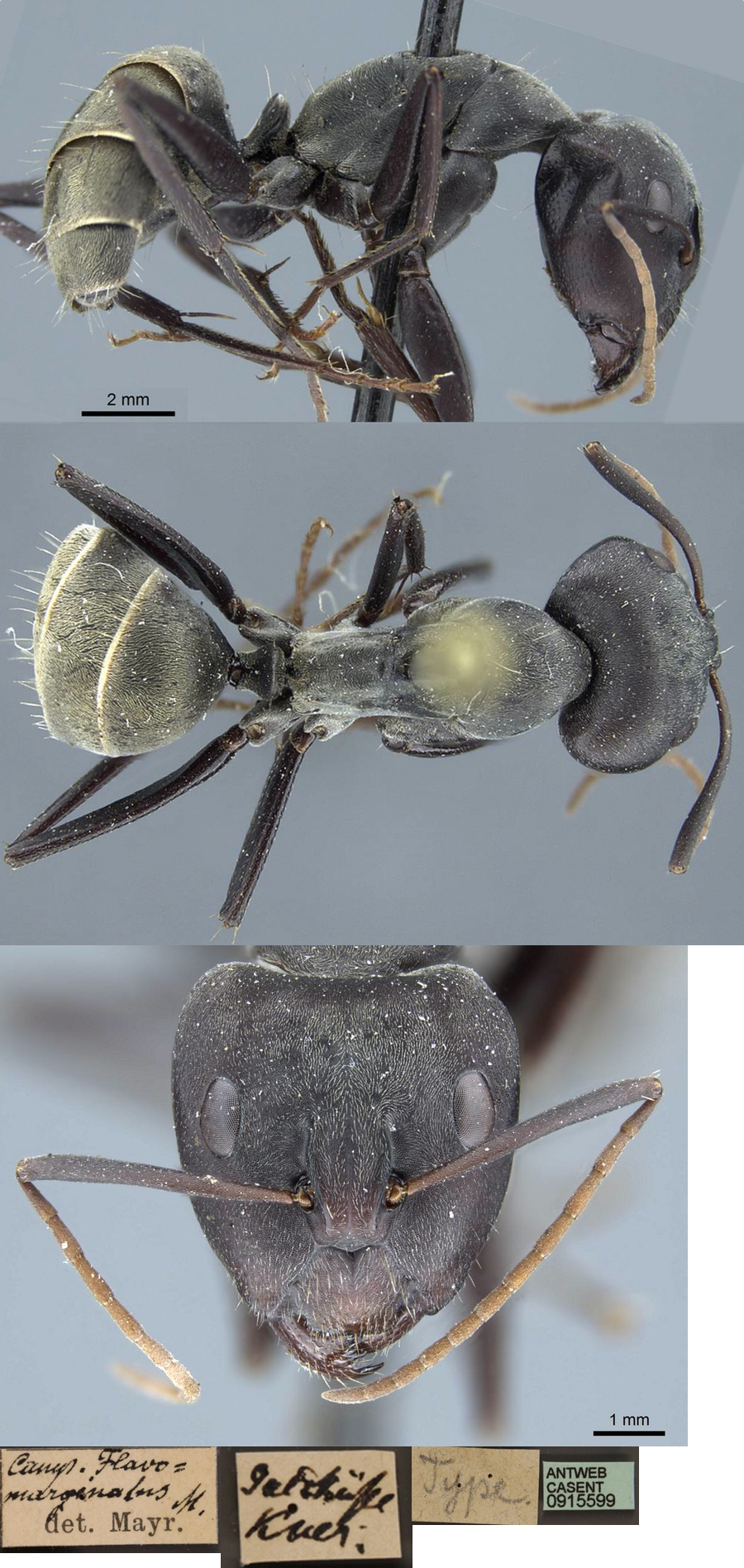 The
photomontage of
a major worker labelled as the type is collated
from http://www.antweb.org/specimen.do?name=casent0915599.
There is no attribution in the original texts that give credibility to
the specimen and the Antweb scales are patently wrong - there are no Camponotus
(Myrmosericus) with a TL ca 19 mm and HW ca 4.8 mm. Given that the
overall morphology and colour (allowing the characteristic magenta tint
common to all Antweb images) appears to be flavomarginatus, I feel that this is a good paratype, if not the holotype. The
photomontage of
a major worker labelled as the type is collated
from http://www.antweb.org/specimen.do?name=casent0915599.
There is no attribution in the original texts that give credibility to
the specimen and the Antweb scales are patently wrong - there are no Camponotus
(Myrmosericus) with a TL ca 19 mm and HW ca 4.8 mm. Given that the
overall morphology and colour (allowing the characteristic magenta tint
common to all Antweb images) appears to be flavomarginatus, I feel that this is a good paratype, if not the holotype.
Now (April 2015) the Antweb page has it as a syntype in
the NHMW, Vienna. The collector's name appears to be "Kner" which
ties in with the Mayr description of Crematogaster kneri, also from the Akwapim Mountains in Gold Coast (Ghana). The true collector, however, appears to have been Georg von Frauenfeld, who was on the Novara Expedition and not Kner.
|
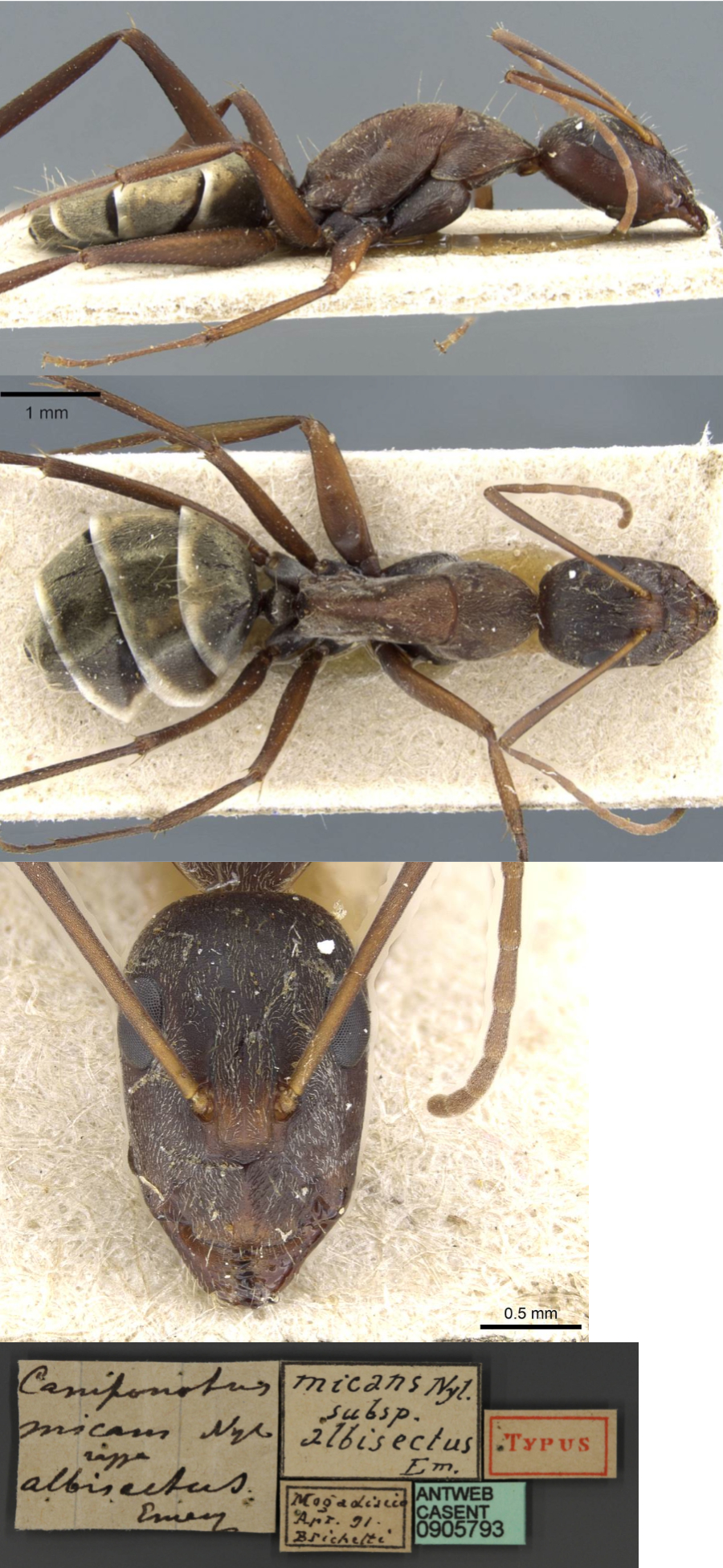 The
photomontage of
a minor worker from the albiscetus type collection is collated
from http://www.antweb.org/specimen.do?name=casent0905793.
The colouration and general morphology place it closer to Camponotus rufoglaucus. The
photomontage of
a minor worker from the albiscetus type collection is collated
from http://www.antweb.org/specimen.do?name=casent0905793.
The colouration and general morphology place it closer to Camponotus rufoglaucus.
|
Oxford
University Museum
specimens
|
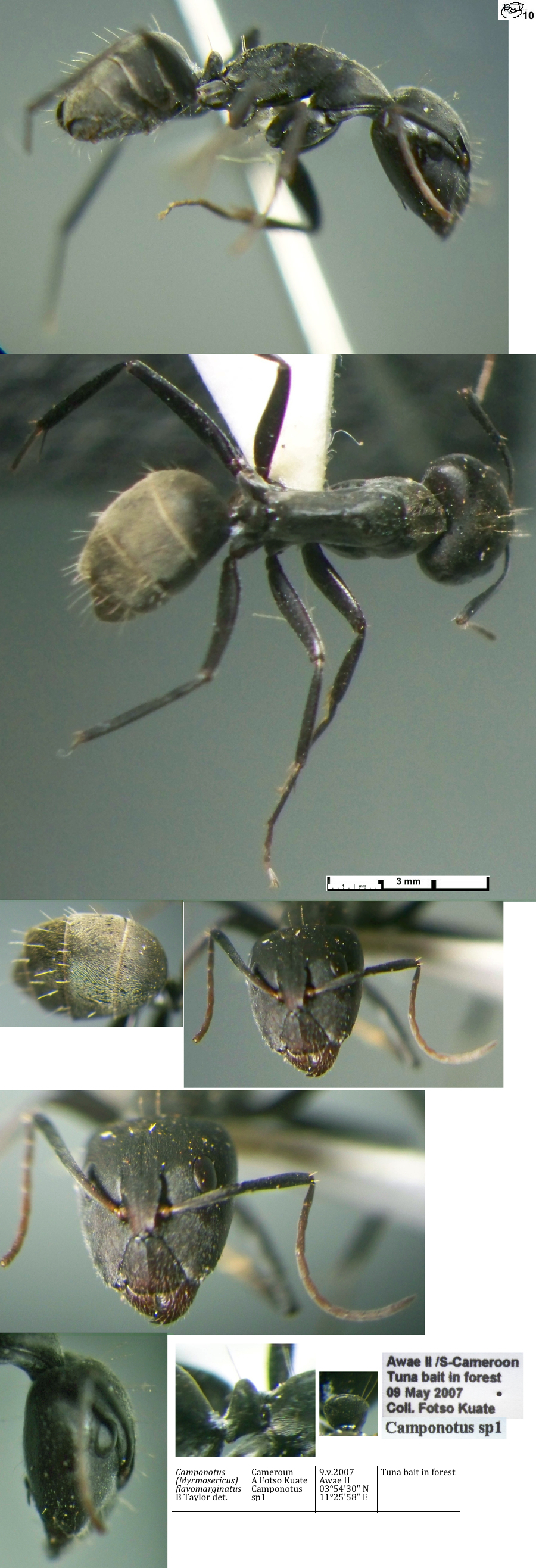 The
photomontage is of a major from Cameroun, Awae II; collector
Fotso Kuate (Camponotus sp1). The
photomontage is of a major from Cameroun, Awae II; collector
Fotso Kuate (Camponotus sp1).
|
 The
photomontage is
of a major from Kenya,
Subukia; collectors Dupont & Braet. Specimen with a light
film of grease obscuring
pubescence to some extent. The
photomontage is
of a major from Kenya,
Subukia; collectors Dupont & Braet. Specimen with a light
film of grease obscuring
pubescence to some extent.
|
 The
photomontage is
of a minor from Congo,
Dzio-Dzio; collector Yves Braet. The
photomontage is
of a minor from Congo,
Dzio-Dzio; collector Yves Braet.
This has the low rounded petiole profile of the minor
I drew in
Nigeria and compares with the sharper petiole of those below.
|
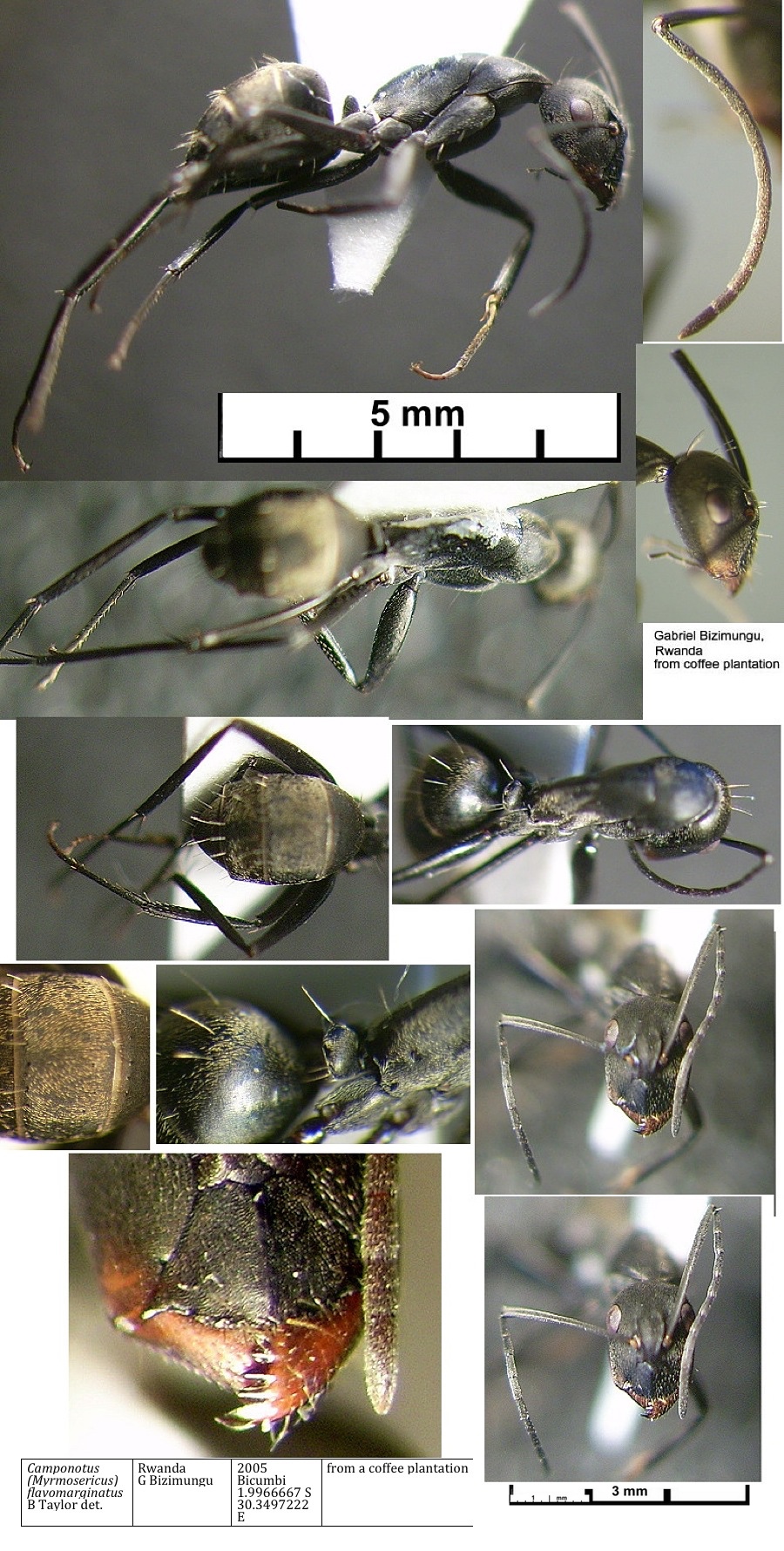 The photomontage is
of minor specimens from Rwanda, near
Kigali, coffee plantation, collector Gabriel Bizimungu (2005). The photomontage is
of minor specimens from Rwanda, near
Kigali, coffee plantation, collector Gabriel Bizimungu (2005).
|
 The photomontage is
of a minor from the Central
African Republic, Dzanga-Sangha National Park; collector Philippe
Annoyer (CAR DAA 2. The photomontage is
of a minor from the Central
African Republic, Dzanga-Sangha National Park; collector Philippe
Annoyer (CAR DAA 2.
|
 The photomontage derived from those of Mike Lush at http://sifolinia.blogspot.com/2008/02/camponotus-flavomarginatus.html The photomontage derived from those of Mike Lush at http://sifolinia.blogspot.com/2008/02/camponotus-flavomarginatus.html
|
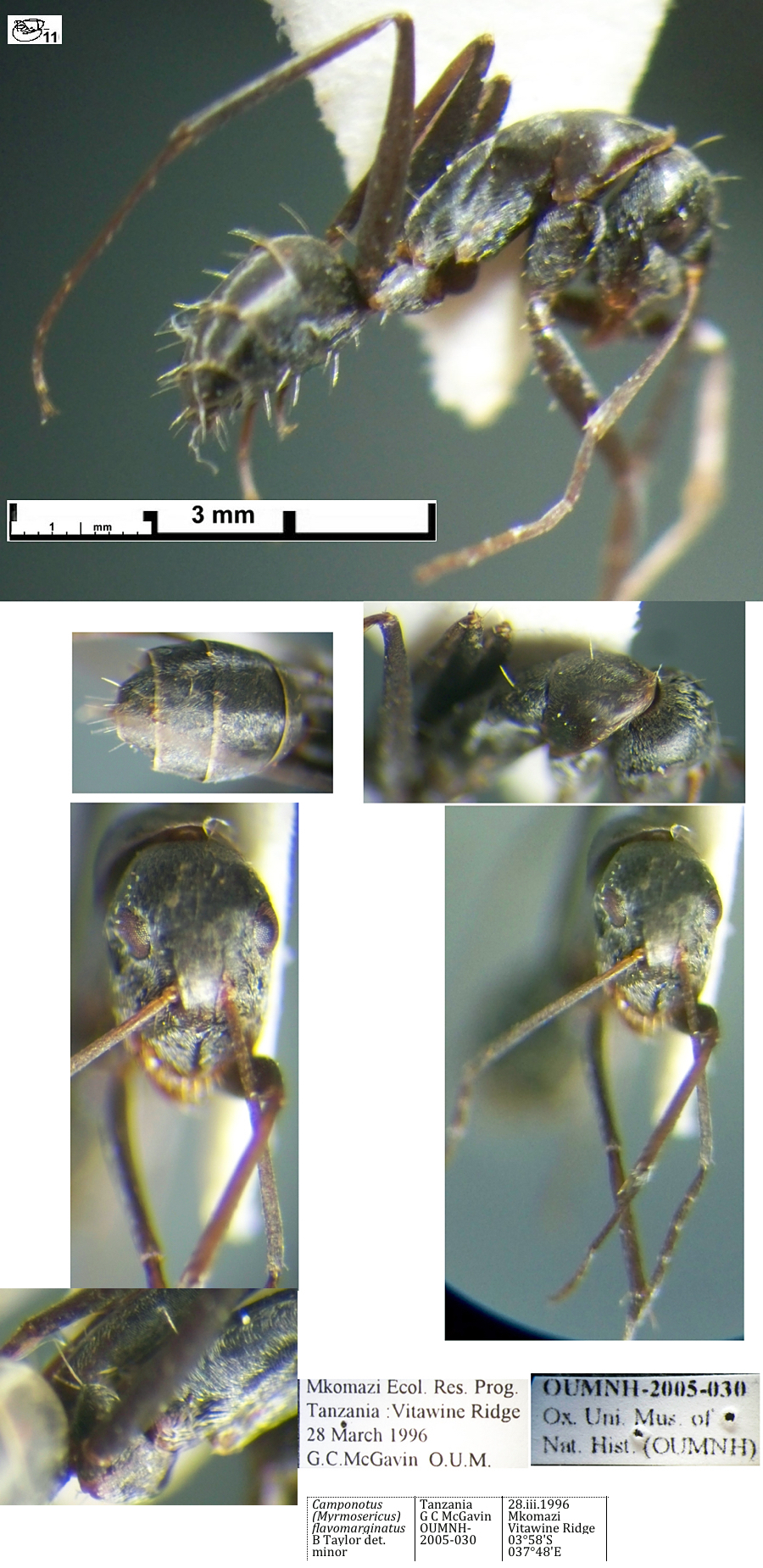 The
photomontage is of
a minor worker from Tanzania,
Mkomazi Game Reserve; collector
G C McGavin; OUMNH 2005-030. The
photomontage is of
a minor worker from Tanzania,
Mkomazi Game Reserve; collector
G C McGavin; OUMNH 2005-030.
|
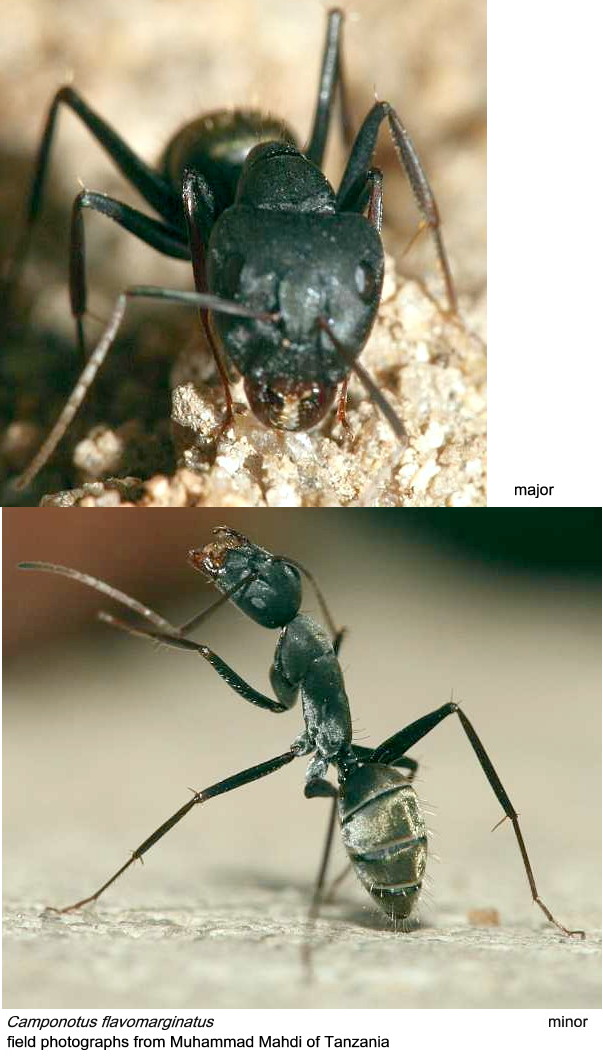 The collated photo is edited from those shown by
Muhammad Mahdi of Tanzania on http://www.diptera.info/forum/viewthread.php?thread_id=19226&pid=86657#post_86657. The collated photo is edited from those shown by
Muhammad Mahdi of Tanzania on http://www.diptera.info/forum/viewthread.php?thread_id=19226&pid=86657#post_86657.
|
|